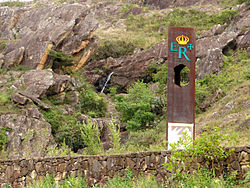Estrada Real

The Estrada Real ("Royal Road") [dead link], in Southeast Brazil, is one of the oldest roads in the Americas. It is becoming a popular itinerary for those in search of culture, history, typical regional food and a large variety of outdoors activities.
Understand
[edit]Cutting through the States of Minas Gerais and São Paulo to the port cities of Paraty and Rio de Janeiro, the Royal Road thrived during the diamond and gold-digging years of the 16th, 17th and 18th centuries, linking many of the most important historic towns in the region.
History
[edit]Portuguese colonists of Brazil and their African slaves began building the road in 1697 shortly after gold, diamonds, and other precious minerals were discovered in the present-day state of Minas Gerais. The purpose of the road was to transport those minerals from the interior to the coast and then to Lisbon. The original road — the Caminho Velho — began in Paraty and went north through the towns of São João del Rey, Tiradentes, Coronel Xavier Chaves, Congonhas, Itatiaia and, ultimately, Vila Rica, today's Ouro Preto. Later, the distance to Ouro Preto was shortened by the Caminho Novo, which started from Rio de Janeiro. The road was extended northward through Mariana, Catas Altas, Santa Bárbara, Barão de Cocais, Ipoema, Conceição do Mato Dentro, Serro, São Gonçalo do Rio das Pedras, and, at the northernmost point, Diamantina. The length of both roads combined is about 1,400 km (850 mi).

Transportation along the road was tightly controlled by agents of the Crown to prevent smuggling and unauthorized movement. Goods were transported in mule trains known as tropas, led by tropeiro mule drivers. Products from Portugal made their way up the road while minerals made their way to the coast, as manufacturing and many crops were prohibited by the Crown so as to keep the region economically dependent on Portugal. Many of Brazil's hearty dishes, such as feijão tropeiro and tutu, were originally prepared by the tropeiros, who needed food that could be transported without spoiling.

The towns along the Estrada Real were opulent in the days of gold and diamonds, but by the end of the 18th century, the minerals became more scarce and the economy went into decline. Governmental and non-governmental organizations have worked to turn the Estrada Real into a route that leads tourists through the cradle of Brazilian culture. The road is still mostly unpaved, and the towns and villages along the way appear much the way they did in the 19th century. Magnificent churches still stand in towns that have been economically stagnant for over a century. The tourism initiative is educating people to retain their traditional ways and preserve the Baroque architecture of their old churches and government buildings
Prepare
[edit]Get in
[edit]While the route can of course be taken in any of its segments, the most convenient starting points for those coming from outside the region are:
- Diamantina, Minas Gerais - at the north end of the route
- Ouro Preto, Minas Gerais - in the center of the route near Belo Horizonte
- Paraty, Rio de Janeiro - at the south end of the western leg
- Petrópolis, Rio de Janeiro - at the south end of the eastern leg near the city of Rio de Janeiro
- Guaratinguetá, São Paulo - on the Presidente Dutra Highway (BR-116), the main highway between São Paulo and Rio de Janeiro
Go
[edit]
Itineraries within that route normally follow:
- Diamond Route (Caminho do Diamante) - from Diamantina to Ouro Preto, via Serro, Barão de Cocais, Catas Altas and Mariana.
- Sabarabuçu Route (Caminho do Sabarabuçu) - an alternative path between Barão de Cocais and Ouro Preto.
From Ouro Preto, the Road splits into:
- Old Route (Caminho Velho) - from Ouro Preto to Paraty, via Tiradentes and Cunha
- New Route (Caminho Novo) - from Ouro Preto to Rio de Janeiro, via Barbacena and Petrópolis


 Français
Français Italiano
Italiano



